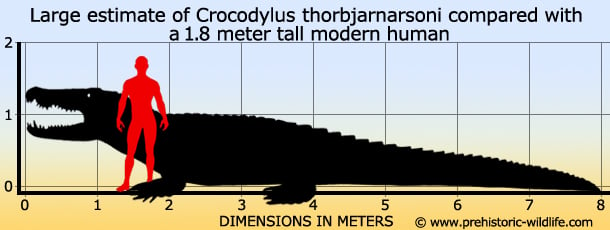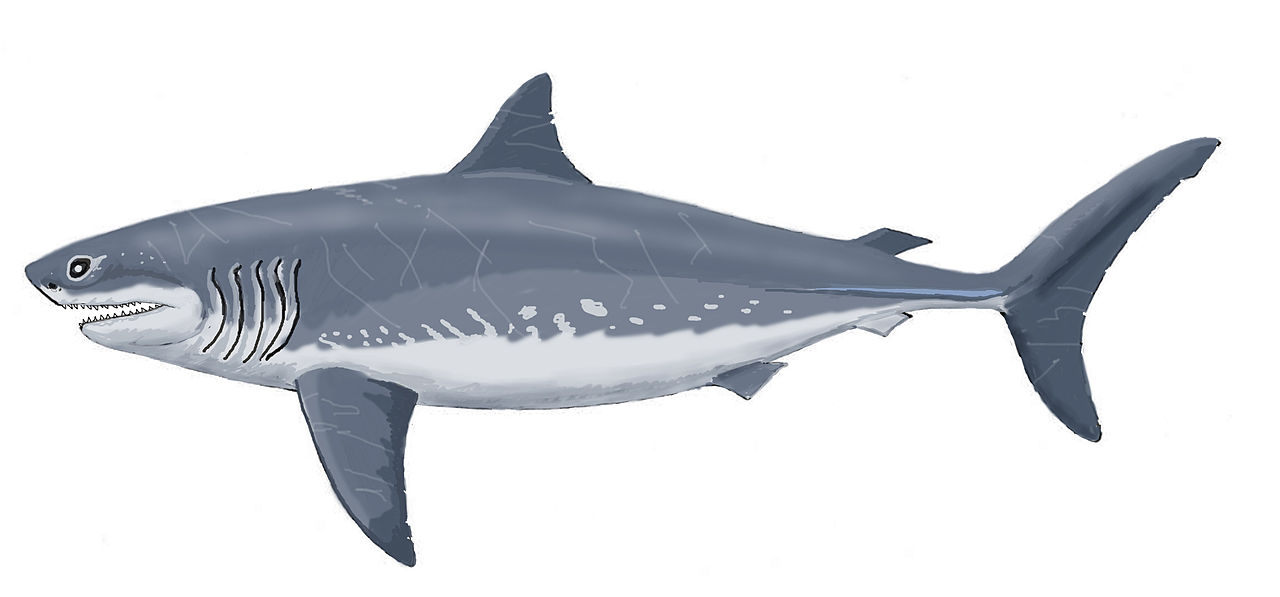Post by dinosauria101 on Sept 2, 2019 18:57:16 GMT 5
Crocodylus thorbjarnarsoni
Crocodylus thorbjarnarsoni is an extinct species of crocodile from the Pliocene and Pleistocene of the Turkana Basin in Kenya. It is closely related to the species Crocodylus anthropophagus, which lived during the same time in Tanzania. C. thorbjarnarsoni could be the largest known true crocodile, with the largest skull found indicating a possible total length up to 7.6 m (25 ft). It may have been a predator of early hominins. The largest C. thorbjarnarsoni skull found (KNM-ER 1682) measures 85 cm (33 in) from the tip of the snout to the back of the skull table, in comparison, the largest known extant Crocodylus skull is that of a saltwater crocodile, measuring 76 cm (30 in). Based on regression analysis for Crocodylus, this corresponds to a total length of 6.2–6.5 m (20–21 ft) but such analysis have been shown to underestimate the size of very large individuals by as much as 20%, which means it could have been as long as 7.6 m (25 ft).

Ginsu Shark - Cretoxyrhina mantelli
Cretoxyrhina mantelli, the "Jaws of the Cretaceous", was a shark that lived in the Cretaceous period in the in the Western Interior Sea, about 100 million years ago. C. mantelli grew up to 24 feet (7 meters) long, and is known from several nearly complete skeletal fossils. Its name means "Mantell's chalk-sharp-nose".According to Shimada, associated fossil remains with evidence of digestive damage suggest that probable fish prey of C. mantelli included the massively jawed, 14-foot (4.25-metre) long Xiphactinus, which resembled a dagger-toothed tarpon and was a powerful predator in its own right. Based on a few tooth-scarred, associated mosasaur vertebrae, Shimada suggests that C. mantelli also tackled these 10- to 40-foot (3- to 12- metre) long marine reptiles of the late Cretaceous. While it is tempting to imagine titanic undersea battles between a giant shark and a sea dragon, it seems far more likely that Cretoxyrhina more commonly fed on large pelagic bony fishes, taking juvenile mosasaurs when the opportunity arose, and perhaps even dining on the occasional long-necked plesiosaur. Shimada concluded that Cretoxyrhina mantelli occupied a top predatory niche comparable to that of the modern White Shark (Carcharodon carcharias). Despite its fearsome size and armament, C. mantelli did not long survive, becoming extinct by about 90 million years ago. Known specimens of the Ginsu Shark are about the same size as the largest recorded Great Whites Sharks.

Credit to Wikipedia
Crocodylus thorbjarnarsoni is an extinct species of crocodile from the Pliocene and Pleistocene of the Turkana Basin in Kenya. It is closely related to the species Crocodylus anthropophagus, which lived during the same time in Tanzania. C. thorbjarnarsoni could be the largest known true crocodile, with the largest skull found indicating a possible total length up to 7.6 m (25 ft). It may have been a predator of early hominins. The largest C. thorbjarnarsoni skull found (KNM-ER 1682) measures 85 cm (33 in) from the tip of the snout to the back of the skull table, in comparison, the largest known extant Crocodylus skull is that of a saltwater crocodile, measuring 76 cm (30 in). Based on regression analysis for Crocodylus, this corresponds to a total length of 6.2–6.5 m (20–21 ft) but such analysis have been shown to underestimate the size of very large individuals by as much as 20%, which means it could have been as long as 7.6 m (25 ft).

Ginsu Shark - Cretoxyrhina mantelli
Cretoxyrhina mantelli, the "Jaws of the Cretaceous", was a shark that lived in the Cretaceous period in the in the Western Interior Sea, about 100 million years ago. C. mantelli grew up to 24 feet (7 meters) long, and is known from several nearly complete skeletal fossils. Its name means "Mantell's chalk-sharp-nose".According to Shimada, associated fossil remains with evidence of digestive damage suggest that probable fish prey of C. mantelli included the massively jawed, 14-foot (4.25-metre) long Xiphactinus, which resembled a dagger-toothed tarpon and was a powerful predator in its own right. Based on a few tooth-scarred, associated mosasaur vertebrae, Shimada suggests that C. mantelli also tackled these 10- to 40-foot (3- to 12- metre) long marine reptiles of the late Cretaceous. While it is tempting to imagine titanic undersea battles between a giant shark and a sea dragon, it seems far more likely that Cretoxyrhina more commonly fed on large pelagic bony fishes, taking juvenile mosasaurs when the opportunity arose, and perhaps even dining on the occasional long-necked plesiosaur. Shimada concluded that Cretoxyrhina mantelli occupied a top predatory niche comparable to that of the modern White Shark (Carcharodon carcharias). Despite its fearsome size and armament, C. mantelli did not long survive, becoming extinct by about 90 million years ago. Known specimens of the Ginsu Shark are about the same size as the largest recorded Great Whites Sharks.

Credit to Wikipedia







